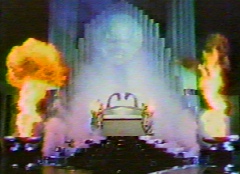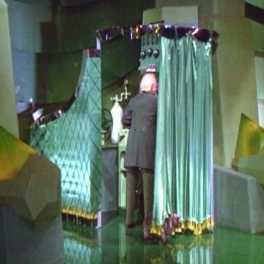 |

|
J.F. Kelley's Professional Bio
Where did the usability term Wizard of Oz come from?
[ Wikipedia article on this topic | Jeff's Personal Page | Jeff's Professional Bio ]
The term Wizard of Oz
(originally OZ Paradigm) has come into common usage in the fields
of Experimental Psychology, Human Factors, Ergonomics and Usability Engineering
to describe a testing or iterative design methodology wherein an experimenter
(the "Wizard"), in a laboratory setting, simulates the behavior of a
theoretical intelligent computer application (often by going into another room
and intercepting all communications between participant and system). Sometimes this is done with the participant's
a-priori knowledge and sometimes it is a low-level deceit employed to manage
the participant's expectations and encourage natural behaviors (though always,
I would hope, with appropriate disclosure during the debriefing part of the
experiments).
I coined that term around 1980 to describe the methodology I
developed during my dissertation work at The Johns Hopkins University (my
dissertation advisor was Professor Alphonse Chapanis, the "Godfather of
Human Factors and Engineering Psychology"). Amusingly enough, in addition to some one-way mirrors and such,
there literally was a curtain separating me, as the "Wizard", from
view by the participant during the study.
Here's an interesting tidbit that you may not find in the
literature: I did originally have a definition for the "OZ" acronym
(aside from the obvious parallels with the1900 book by L. Frank Baum). "Offline Zero" was a reference to
the fact that an experimenter (the "Wizard") was interpreting the
users' inputs in real time during the simulation phase. Folks laughed at this lily-gilding as an expression
of my acronymophillia and I eventually dropped it.
The OZ methodology is very powerful. In its original application, I was able to create a simple keyboard-input natural language recognition system that far exceeded the recognition rates of any of the far more complex systems of the day. The key enabling factor was that the system was designed to work in a single context (calendar-keeping), which constrained the complexity of language encountered from users to the extent where a simple language processing model was sufficient to meet the goals of the application. (The processing model was a two-pass keyword/keyphrase matching approach, based loosely on the algorithms employed in Weizenbaum's famous Eliza program).
OZ was important because it addressed the obvious criticism:
Who can afford to use an iterative methodology to build a separate natural language system (dictionaries, syntax) for each new context?
The answer turned out to be:
By using an empirical approach like OZ, anyone can afford to do this; my dictionary and syntax growth reached asymptote (better than 90% recognition) after only 16 experimental trials and my resulting program, with dictionaries, was less than 300k of code.
References
Here are some of the original (and subsequent) references on the subject (the method has been picked up in many research domains, and there are numerous subsequent references, only a few of which are listed here).
Summary of the technical aspects of the work:
Kelley, J.F., “CAL – A Natural Language program developed with the OZ Paradigm: Implications for Supercomputing Systems”. First International Conference on Supercomputing Systems (St. Petersburg, Florida, 16-20 December 1985), New York: ACM, pp. 238-248
Brief description of the method:
Kelley, J.F., “An empirical methodology for writing user-friendly natural language computer applications”. Proceedings of ACM SIG-CHI ’83 Human Factors in Computing systems (Boston, 12-15 December 1983), New York: ACM, pp. 193-196. [1]
The best description of the method:
Kelley, J.F., “An iterative design methodology for user-friendly natural language office information applications”. ACM Transactions on Office Information Systems, March 1984, 2:1, pp. 26-41.[2]
The unpublished dissertation itself:
Kelley, J.F., “Natural Language and computers: Six empirical steps for writing an easy-to-use computer application”. Unpublished doctoral dissertation, The Johns Hopkins University, 1983. (Item 8321592 can be obtained from University Microfilms International; 300 North Zeeb Road; Ann Arbor, Michigan 48106.)
Subsequent References and implementations (a sampling of 20+ years of citations):
Akers, D. 2006. Wizard of Oz for participatory design: inventing a gestural interface for 3D selection of neural pathway estimates. In CHI ’06 Extended Abstracts on Human Factors in Computing Systems (Montréal, Québec, Canada, April 22 - 27, 2006). CHI ’06. ACM Press, New York, NY, 454-459. [3]
Höysniemi, J., Hämäläinen, P., and Turkki, L. 2004. Wizard of Oz prototyping of computer vision based action games for children. In Proceeding of the 2004 Conference on interaction Design and Children: Building A Community (Maryland, June 01 - 03, 2004). IDC ’04. ACM Press, New York, NY, 27-34. [4]
Molin, L. 2004. Wizard-of-Oz prototyping for co-operative interaction design of graphical user interfaces. In Proceedings of the Third Nordic Conference on Human-Computer interaction (Tampere, Finland, October 23 - 27, 2004). NordiCHI ’04, vol. 82. ACM Press, New York, NY, 425-428. [5]
Lai, J. and Yankelovich, N. 2003. Conversational speech interfaces. In the Human-Computer interaction Handbook: Fundamentals, Evolving Technologies and Emerging Applications, J. A. Jacko and A. Sears, Eds. Human Factors And Ergonomics. Lawrence Erlbaum Associates, Mahwah, NJ, 698-713.
Gleicher, M. L., Heck, R. M., and Wallick, M. N. 2002. A framework for virtual videography. In Proceedings of the 2nd international Symposium on Smart Graphics (Hawthorne, New York, June 11 - 13, 2002). SMARTGRAPH ’02, vol. 24. ACM Press, New York, NY, 9-16. [6]
Klemmer, S. R., Sinha, A. K., Chen, J., Landay, J. A., Aboobaker, N., and Wang, A. 2000. Suede: a Wizard of Oz prototyping tool for speech user interfaces. In Proceedings of the 13th Annual ACM Symposium on User interface Software and Technology (San Diego, California, United States, November 06 - 08, 2000). UIST ’00. ACM Press, New York, NY, 1-10. [7]
Hewett, Thomas T. (et al), “Curricula for Human-Computer Interaction”, ACM SIGCHI, 1992, 1996, Chapter 2. [8]
Piernot, P. P., Felciano, R. M., Stancel, R., Marsh, J., and Yvon, M. 1995. Designing the PenPal: blending hardware and software in a user-interface for children. In Proceedings of the SIGCHI Conference on Human Factors in Computing Systems (Denver, Colorado, United States, May 07 - 11, 1995). I. R. Katz, R. Mack, L. Marks, M. B. Rosson, and J. Nielsen, Eds. Conference on Human Factors in Computing Systems. ACM Press/Addison-Wesley Publishing Co., New York, NY, 511-518. [9]
Prager, J. M., Lamberti, D. M., Gardner, D. L., and Balzac, S. R. 1990. REASON: an intelligent user assistant for interactive environments. IBM Syst. J. 29, 1 (Jan. 1990), 141-164.
Dahlbäck, N. and Jönsson, A. 1989. Empirical studies of discourse representations for natural language interfaces. In Proceedings of the Fourth Conference on European Chapter of the Association For Computational Linguistics (Manchester, England, April 10 - 12, 1989). European Chapter Meeting of the ACL. Association for Computational Linguistics, Morristown, NJ, 291-298. [10]
Carroll, J. and Aaronson, A. 1988. Learning by doing with simulated intelligent help. Commun. ACM 31, 9 (Aug. 1988), 1064-1079. [11]
Gould, J. D. and Lewis, C. 1985. Designing for usability: key principles and what designers think. Commun. ACM 28, 3 (Mar. 1985), 300-311. [12]
Embley, D. W. and Kimbrell, R. E. 1985. A scheme-driven natural language query translator. In Proceedings of the 1985 ACM Thirteenth Annual Conference on Computer Science (New Orleans, Louisiana, United States). CSC ’85. ACM Press, New York, NY, 292-297. [13]
Good, M. D., Whiteside, J. A., Wixon, D. R., and Jones, S. J. 1984. Building a user-derived interface. Commun. ACM 27, 10 (Oct. 1984), 1032-1043. [14]
Fictional references
The name of the experiment comes from The Wonderful Wizard of Oz story, in which an ordinary man hides behind a curtain and pretends, through the use of “amplifying” technology, to be a powerful wizard.
In David Lodge’s novel Small World, a university lecturer in English literature is introduced to a computer program named ELIZA, which he believes is capable of conducting a coherent conversation with him. It transpires that a computer lecturer is operating the computer and providing all the responses.
